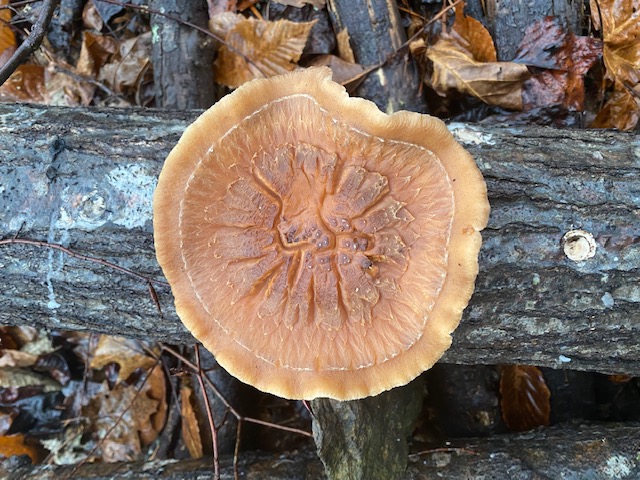Tapeworms, Termites, & Mushroom Questions
go.ncsu.edu/readext?840123
en Español / em Português
El inglés es el idioma de control de esta página. En la medida en que haya algún conflicto entre la traducción al inglés y la traducción, el inglés prevalece.
Al hacer clic en el enlace de traducción se activa un servicio de traducción gratuito para convertir la página al español. Al igual que con cualquier traducción por Internet, la conversión no es sensible al contexto y puede que no traduzca el texto en su significado original. NC State Extension no garantiza la exactitud del texto traducido. Por favor, tenga en cuenta que algunas aplicaciones y/o servicios pueden no funcionar como se espera cuando se traducen.
Português
Inglês é o idioma de controle desta página. Na medida que haja algum conflito entre o texto original em Inglês e a tradução, o Inglês prevalece.
Ao clicar no link de tradução, um serviço gratuito de tradução será ativado para converter a página para o Português. Como em qualquer tradução pela internet, a conversão não é sensivel ao contexto e pode não ocorrer a tradução para o significado orginal. O serviço de Extensão da Carolina do Norte (NC State Extension) não garante a exatidão do texto traduzido. Por favor, observe que algumas funções ou serviços podem não funcionar como esperado após a tradução.
English
English is the controlling language of this page. To the extent there is any conflict between the English text and the translation, English controls.
Clicking on the translation link activates a free translation service to convert the page to Spanish. As with any Internet translation, the conversion is not context-sensitive and may not translate the text to its original meaning. NC State Extension does not guarantee the accuracy of the translated text. Please note that some applications and/or services may not function as expected when translated.
Collapse ▲Some excellent questions came into the Caldwell Extension Center recently. I’d like to share three of them with you. I hope you find these questions and their answers helpful. If you have a specific question not answered here, please contact the Caldwell Extension Center.
Question: I found a few white worms about 1/4 the size of a grain of rice stuck to our dog’s skin. Any idea what it is?
Answer: It is likely a tapeworm. Several species of tapeworms can infect dogs. The most common is the canine tapeworm.
The canine tapeworm has three life stages. These are egg, larva, and adult. The adult canine tapeworm lives inside a dog, and it sheds eggs through the dog’s feces. These eggs hatch into larva. The larvae are eaten by fleas. Then the tapeworm infected fleas are eaten by a dog to complete the lifecycle. If the tapeworm larva is not first eaten by a flea, it cannot infect a dog. It is common for internal parasites to require multiple hosts to complete its life cycle.
Tapeworms are easy to control with dewormer medicine. If fleas are discovered, they should be controlled, too. Work with your veterinarian to confirm the diagnosis and discuss treatment.
Question: Our church received a notice about a supplemental termite treatment from our pest control company. Is this needed?
Answer: Current termite treatments last between 5 and 10 years. Once the initial soil treatment breaks down, the options are basically yearly termite inspections, monitoring stations, periodic re-treatment, or some combination of these options. If it has been ten years since the church was treated, a retreatment may be something to consider.
The initial termite treatment came with a contract that covered several key points. These include if periodic inspections will be made, conditions under which re-treatments will be made, and the price to be charged for treatment service.
Read your contract to see what it covers. Some termite treatment contracts offer no warranty, but some offer free re-treatment if damage occurs, and some even offer damage repair. The North Carolina Department of Agriculture regulates structural pest control operators. They assist citizens that have questions about termite contracts and warranties. They can be reached at (919)733-6100. Two good factsheets titled “Termites – Preventing Problems in Existing Homes” and “Termite Prevention – Approaches for New Construction” are available through the Caldwell Extension Center.
Question: We have 2 logs that we think were plugged with shiitake, oyster, and portobello plugs. Below is what has sprouted from one of the logs. It doesn’t look anything like what was presumed planted. Do you know what kind of mushroom this could be?

Answer: This is a very mature shiitake mushroom. At this stage of maturity, the gills of the mushroom are woody. Shiitake mushrooms should still have some curl to the edge of the mushroom cap. Even after the mushroom is picked it will continue to grow just a little bit, so harvest these early for best results. It takes about four days for the mushrooms to go from the size of a popcorn kernel to ready for harvest.
We have a factsheet titled “Producing Shiitake Mushrooms: A Guide for Small-Scale Outdoor Cultivation on Logs”. This factsheet addresses the major issues involved with shiitake mushroom production.
For answers to your agriculture questions, call the N.C. Cooperative Extension, Caldwell County Center at 828-757-1290 or visit us online any time at https://caldwell.ces.ncsu.edu.
— Seth Nagy is the Caldwell County Cooperative Extension director. The N.C. Cooperative Extension, Caldwell County Center, 120 Hospital Ave. #1 in Lenoir, provides access to resources of NC State University and N.C. A&T State University through educational programs and publications.




